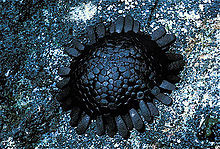- Shingle urchin
-
Shingle urchin 
Scientific classification Kingdom: Animalia Phylum: Echinodermata Subphylum: Eleutherozoa Class: Echinoidea Subclass: Euechinoidea Superorder: Echinacea Order: Echinoida Family: Echinometridae Genus: Colobocentrotus Species: C. atratus Binomial name Colobocentrotus atratus
Linnaeus, 1758Synonyms Podophora atrata
The shingle urchin or helmet urchin (Colobocentrotus atratus) is a species of sea urchin in the family Echinometridae.[1] In Hawaii it is known as "kaupali" which translates as "cliff-clinging". It is found on wave-swept intertidal shores in the Indo-West Pacific, particularly on the shores of Hawaii.
Contents
Description
This urchin is a deep maroon colour and shaped like a domed limpet. It can grow as big as a soft ball but is usually much smaller. The upper surface is a mosaic of tiny polygonal plates formed from modified spines to form a smooth mosaic. This is fringed by a ring of large, flattened modified spines. On the underside there is another ring of smaller flattened spines and a large number of tube feet.[2]
Biology
This urchin is usually found on substrates fully exposed to waves and their associated abrasive effect, often in groups. It feeds on periwinkles, other urchins and coralline algae.
In a test comparing shingle urchins to other species of urchin, it was found that their ability to withstand being washed away by moving water excelled. A combination of their shape, their flattened spines and particularly the strong adhesion of their tube feet made them three times as resistant as other species such as Echinometra. This enables them to live on inhospitable wave-battered shorelines.[3]
References
External links
Categories:- Echinoidea
- Animals described in 1758
Wikimedia Foundation. 2010.
